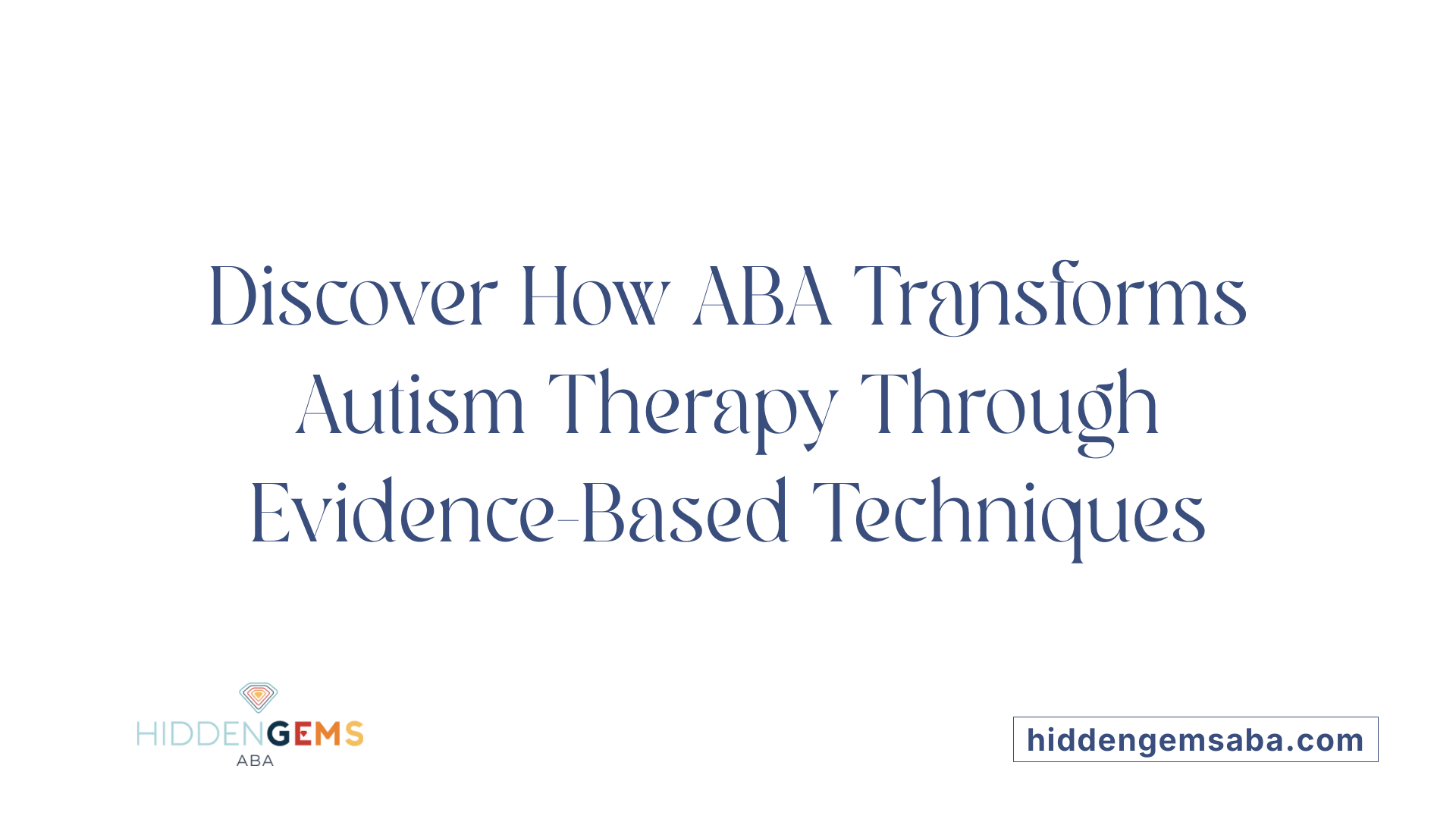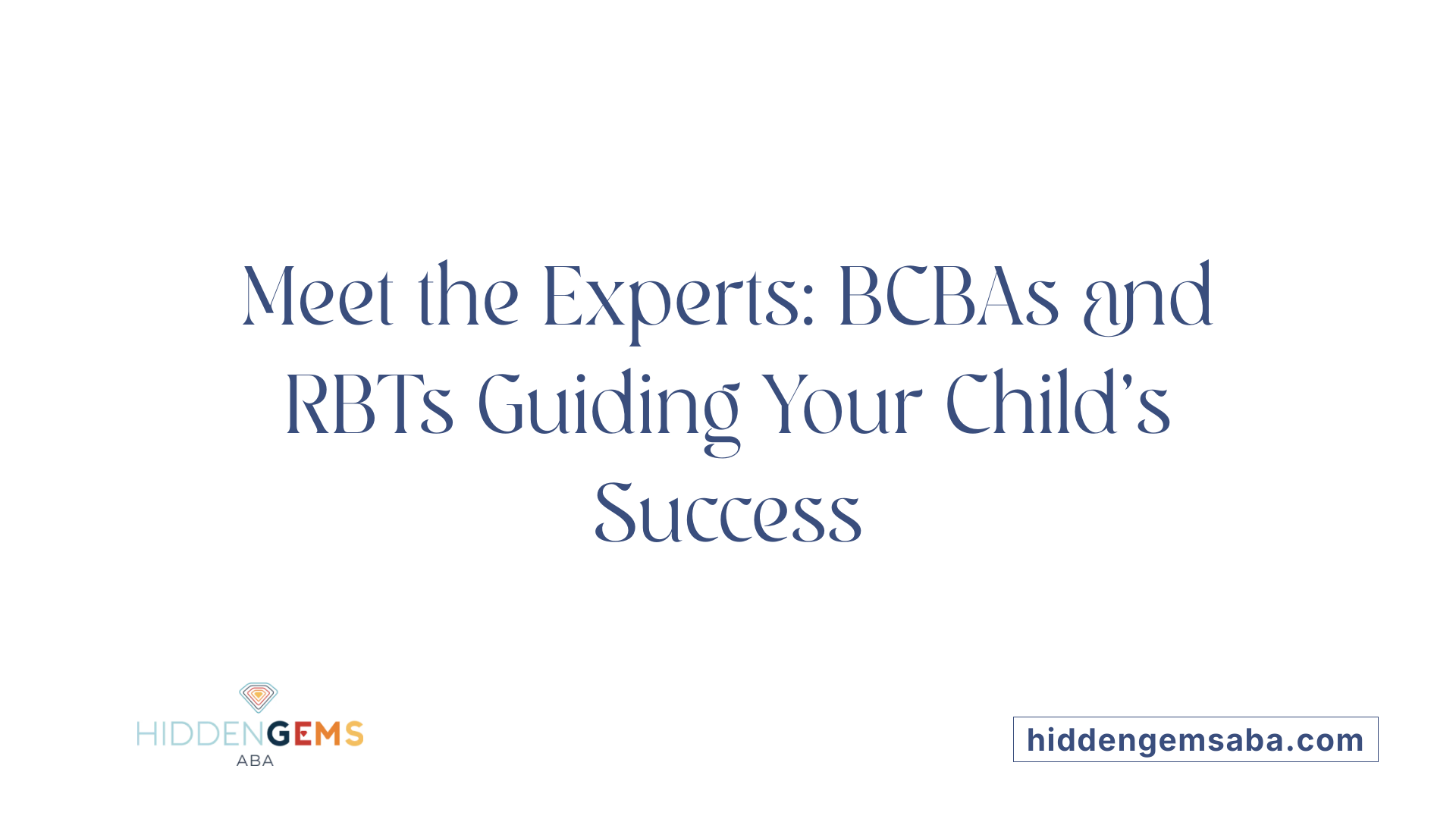Introduction to ABA Therapy Consultation
Applied Behavior Analysis (ABA) therapy is a cornerstone intervention for individuals on the autism spectrum. This article explores the consultation process for ABA therapy, detailing what ABA is, who provides it, the structure of treatment sessions, and the key benefits it brings. It also addresses practical considerations families face when seeking these important services, helping to demystify the journey toward impactful behavioral support.
What is Applied Behavior Analysis (ABA) Therapy and Its Role in Autism Treatment?

What is Applied Behavior Analysis (ABA) therapy and how is it used to treat autism?
Applied Behavior Analysis (ABA) therapy is an evidence-based approach grounded in the science of learning and behavior. It aims to improve social skills, communication, academic abilities, and reduce problem behaviors, particularly for individuals on the autism spectrum. This therapy works by identifying and reinforcing helpful behaviors, while decreasing behaviors that interfere with learning and engagement.
How does ABA use positive reinforcement?
A central technique in ABA is positive reinforcement, which rewards desired behaviors to encourage their recurrence. For example, a child may receive praise or a small reward when they successfully complete a task or use appropriate communication. This strategy helps build new skills and increases motivation.
What is the behavior analysis framework used in ABA?
ABA utilizes the ABCs framework — Antecedent, Behavior, Consequence — to examine what triggers a behavior, the behavior itself, and the result that follows. Understanding these components enables therapists to modify the environment and responses, shaping more positive behaviors over time.
How are ABA programs individualized?
Treatment plans are tailored by Board Certified Behavior Analysts (BCBAs) to meet the unique needs of each individual. They assess skills, set achievable goals, and continuously adjust interventions based on progress. Common goals include enhancing communication, social interactions, self-care, and academic skills.
What techniques are commonly used in ABA?
ABA therapy employs various methods, such as:
- Discrete Trial Training (DTT): Structured, one-on-one teaching sessions.
- Pivotal Response Treatment (PRT): Naturalistic, play-based techniques focusing on motivation.
- Early Start Denver Model (ESDM): Combines developmental and behavioral approaches tailored for young children.
These approaches break skills into manageable steps that can be practiced and generalized.
How does ABA promote independence and skill building?
The ultimate goal of ABA is to foster independence by teaching individuals skills to navigate daily life, communicate effectively, and engage socially. Therapists often involve families to support skill generalization across settings like home and school. Through ongoing assessment and collaboration, ABA encourages long-term success and improved quality of life.
Professionals Behind ABA Therapy: Roles and Qualifications

Who Typically Provides ABA Therapy for Individuals with Autism?
ABA therapy is delivered by a team of qualified professionals working closely together to support individuals with autism.
Board Certified Behavior Analysts (BCBAs)
BCBAs are highly trained professionals with at least a master's degree in behavior analysis or a related field, along with certification and licensing. They are responsible for assessing client needs, designing individualized treatment plans, setting measurable goals, and overseeing therapy programs. BCBAs regularly review progress and adjust interventions to maximize therapeutic outcomes.
Registered Behavior Technicians (RBTs)
RBTs and therapists are the frontline providers who implement ABA interventions directly with clients. They carry out therapy sessions based on the BCBA's plan, using techniques such as positive reinforcement and prompting. RBTs receive specialized training and certification to ensure fidelity to behavioral protocols and best practices.
Specialist Training and Certifications
Both BCBAs and RBTs undergo rigorous training and credentialing processes. BCBAs must pass a certification exam and fulfill continuing education requirements. RBTs complete training programs and competency assessments to become certified.
Supervision and Oversight
BCBAs provide supervision to RBTs and other therapy staff, ensuring that interventions are applied accurately and safely. They hold regular team meetings and collaborate to problem-solve challenges.
Collaboration with Families
An essential element of ABA therapy is working collaboratively with families. BCBAs and therapists engage families by educating them on ABA principles, involving them in goal setting, and training them to reinforce skills at home.
Settings Where Therapy is Provided
ABA therapy takes place in flexible settings customized to individual needs, including the client's home, schools, clinics, or community locations. This adaptability enhances generalization of skills across environments.
Together, this multidisciplinary team fosters personalized, effective treatment that supports the growth and independence of individuals receiving ABA therapy.
Structure and Methods of ABA Therapy Sessions

Individualized Goal-Setting
ABA therapy begins with personalized goal-setting led by a Board Certified Behavior Analyst (BCBA). These goals target areas such as communication, social skills, self-care, and academic performance, tailored specifically to the individual's strengths and challenges.
Session Formats and Techniques
Sessions often combine structured instruction and play-based learning. Two main approaches utilized include Discrete Trial Training (DTT) and naturalistic methods like Pivotal Response Treatment (PRT) and the Early Start Denver Model (ESDM).
Discrete Trial Training (DTT)
DTT is a highly structured method where therapists provide clear instructions and repeated practice opportunities. It focuses on breaking skills into small, teachable components using errorless learning, which helps build foundational skills efficiently.
Pivotal Response Treatment (PRT)
PRT takes a more naturalistic, child-led approach, encouraging learning through play and interests. This method emphasizes motivation and response to multiple cues, promoting generalization of skills in real-life contexts.
Early Start Denver Model (ESDM)
The ESDM blends play, natural reinforcement, and behavioral principles to engage young children, promoting social communication and cognitive growth.
Use of Positive Reinforcement
Central to all ABA approaches is positive reinforcement. Desired behaviors are immediately followed by rewards such as praise, tokens, or access to preferred activities, increasing the likelihood the behavior will recur.
Data Collection and Progress Tracking
Therapists collect detailed data during sessions on behavior frequency, duration, and intensity. This ongoing monitoring enables the BCBA to analyze progress, adjust interventions, and refine treatment goals.
Therapy Flexibility and Engagement
ABA sessions are flexible, occurring in homes, schools, or community settings. They are designed to be engaging and geared toward the child's individual needs to maintain motivation and enhance learning.
This comprehensive and adaptable structure ensures ABA therapy effectively supports skill acquisition and behavior improvement, creating meaningful changes in daily functioning.
Key Benefits of ABA Therapy for Individuals with Autism

How Does ABA Therapy Improve Communication and Social Skills?
ABA therapy prioritizes enhancing communication and social interactions in individuals with autism. It employs strategies such as positive reinforcement and modeling to encourage the development of language and pragmatic skills. This fosters improved expression of needs and better social engagement, enabling individuals to connect more effectively with others.
In What Ways Does ABA Reduce Harmful or Challenging Behaviors?
A core component of ABA therapy is decreasing harmful or hindering behaviors. By using the ABCs framework (Antecedent, Behavior, Consequence), therapists identify the triggers and outcomes of behaviors to tailor interventions. Positive reinforcement encourages the repetition of helpful behaviors, while problematic behaviors are replaced with constructive alternatives.
How Does ABA Contribute to the Development of Life Skills and Independence?
ABA therapy supports individuals in acquiring essential life skills such as self-care, dressing, eating, and emotional regulation. These skills promote greater independence and self-advocacy. The therapy adapts to individual needs and integrates family involvement, allowing for skill generalization across settings and throughout daily life.
What Evidence Supports ABA's Effectiveness?
Research from over 20 studies confirms that intensive, long-term ABA therapy significantly improves intellectual abilities, language, daily living skills, and social functioning. Early intervention, especially before age 4 and with more than 20 hours weekly, leads to large developmental gains and can reduce the need for future specialized services.
How Accessible Is ABA Therapy Across Different Environments?
ABA is a flexible treatment provided in diverse settings, including homes, schools, and community environments. Services may involve direct therapy sessions and parent training, overseen by Board Certified Behavior Analysts (BCBAs) and implemented by Registered Behavior Technicians (RBTs). This accessibility ensures therapy can be tailored to fit the individual's daily life circumstances.
What Long-Term Functional Gains and Quality of Life Enhancements Does ABA Offer?
Long-term ABA therapy promotes sustained improvements in behavior and learning, fostering independence and social connections. Through continuous progress monitoring and strategy adjustments, ABA supports ongoing development, improved quality of life, and successful transitions to various life stages.
| Benefit Area | Description | Outcome Example |
|---|---|---|
| Communication & Social Skills | Enhances language use and social interaction | Improved expressive language and peer engagement |
| Behavior Reduction | Decreases harmful behaviors via ABC framework and reinforcement | Reduction in tantrums or self-injury |
| Life Skills Development | Teaches daily living and self-care skills | Independently dressing and eating |
| Evidence-Based Practice | Supported by multiple rigorous studies | Documented intellectual and social gains |
| Therapy Accessibility | Provided in homes, schools, community settings | Tailored sessions fitting family routines |
| Quality of Life Enhancement | Supports independence and social integration | Greater self-advocacy and social participation |
Navigating the ABA Therapy Consultation and Assessment Process

What Happens During the Initial Consultation?
The first step in ABA therapy is the initial consultation, where a Board Certified Behavior Analyst (BCBA) meets with the individual and their family. This meeting focuses on understanding the person's unique needs and family dynamics. During this session, the BCBA discusses ABA principles, sets preliminary goals, and outlines the intervention plan.
How Are Assessments Conducted? Including Functional Behavior Assessment (FBA)
Following the consultation, a comprehensive assessment is performed to gather detailed information. This includes a Functional Behavior Assessment (FBA), which analyzes the antecedents, behaviors, and consequences to pinpoint behavior triggers and motivations. Additional skill assessments and family input are collected, enabling the BCBA to create an informed profile of strengths and challenges.
How Are Individualized Treatment Plans Developed?
Using assessment data, the BCBA designs a personalized treatment plan. This plan specifies behavioral interventions such as positive reinforcement, prompting, and modeling. The approach is tailored to encourage development in communication, social skills, self-care, play, motor abilities, and academics.
What Are the Measurable Goals in an ABA Plan?
Goals are specific and measurable, enabling clear progress tracking. They often focus on improving communication, social interaction, self-help skills, and reducing challenging behaviors, aiming for greater independence and quality of life.
How Does Family Involvement and Education Play a Role?
Active family participation is essential. Families receive training to support generalizing skills to daily life and maintain consistency. Education about ABA principles empowers families to reinforce positive behaviors outside therapy sessions.
How Is Insurance Verification and Provider Selection Managed?
Before therapy begins, insurance coverage is verified, including private insurance or Medicaid, especially when deemed medically necessary. Families may select providers based on credential verification, staff training, supervision quality, and services offered.
How Is Collaborative Care and Ongoing Evaluation Maintained?
ABA therapy includes ongoing data collection and progress monitoring. The BCBA regularly reviews outcomes, adjusts strategies, holds team meetings, and celebrates successes to keep motivation high. Collaboration with other professionals ensures comprehensive support for the individual's growth.
Ensuring Quality and Accessibility in ABA Therapy Services
What Professional Credentials and Accreditation Ensure Quality in ABA Therapy?
ABA therapy is delivered by professionals with specialized training. At the helm are Board Certified Behavior Analysts (BCBAs) who possess master's degrees, certification, and relevant licensing. These experts design and oversee individualized treatment plans. Registered Behavior Technicians (RBTs) implement therapy sessions under BCBA supervision. Quality providers, like the accredited Behavioral Health Centers of Excellence, adhere to high clinical standards ensuring effective service delivery.
How Are Safety and Supervision Maintained?
ABA providers maintain strict supervision with BCBAs overseeing direct therapy by RBTs. Safety protocols and staff training are regularly updated, emphasizing secure and supportive environments for clients. Transparent communication regarding staff credentials, ongoing training, and session oversight enhances confidence for families.
What is the Availability of Sessions and How Are Waitlists Managed?
Access to ABA therapy varies based on provider capacity and region. Many providers offer flexible scheduling including in-home, school-based, and community sessions to meet diverse needs. Providers typically inform families about waitlists and expected start dates. Early consultation and assessment can expedite entry into therapy.
How Does Insurance Coverage Affect Access and What Financial Considerations Are Involved?
Insurance coverage for ABA therapy, including private plans and Medicaid, often requires prescriptions marking therapy as medically necessary. Coverage can vary, so consulting health care providers and insurers beforehand is essential. Providers assist families in navigating benefits and may offer guidance on financial assistance or payment plans.
What Settings Are Services Provided In?
ABA programs are adaptable and delivered across settings such as the home, school, and community. This flexibility facilitates skill generalization and natural learning opportunities, integrating therapy seamlessly into daily life.
How Are Families Supported Through Training?
Family involvement is vital. Providers offer parent training to empower caregivers with ABA principles, enabling them to reinforce skills at home. Education sessions clarify therapy goals and methods, fostering collaborative care.
How Is Progress Monitored and Therapy Adapted?
Ongoing data collection and analysis allow behavior analysts to monitor client progress closely. Therapy strategies are continuously adjusted based on this data to maximize effectiveness. Regular review meetings with families celebrate successes and plan next steps.
| Aspect | Details | Impact |
|---|---|---|
| Credentials & Accreditation | BCBAs and RBTs; accredited centers | Ensures professional standards and reliable care |
| Safety & Supervision | Trained staff, session oversight | Creates secure, effective therapy environments |
| Session Availability | In-home, school, community; waitlist management | Enhances accessibility and flexible scheduling |
| Insurance Coverage | Private and Medicaid plans; requires medical necessity | Influences affordability and access |
| Service Settings | Multiple locations to aid skill generalization | Promotes practical skill use |
| Family Training | Parent education and involvement | Strengthens therapy outcomes through home support |
| Progress Monitoring | Data-driven adjustments and regular reviews | Maintains therapy relevance and effectiveness |
Conclusion: Empowering Families Through ABA Therapy Consultation
ABA therapy consultation serves as the critical first step toward tailored interventions that significantly enhance the lives of individuals with autism. By understanding what ABA entails, knowing who delivers the therapy, recognizing the structured yet flexible nature of treatment sessions, and appreciating the substantial benefits, families can navigate the process with confidence. Quality consultations and ongoing assessments ensure that therapy goals align with individual needs, fostering skill development and independence. With the support of qualified professionals and accessible services, ABA therapy stands as a powerful tool to promote meaningful progress and improved quality of life.
References
- Applied Behavior Analysis (ABA)
- Understanding the Role of ABA Agencies in Autism Support
- Applied Behavior Analysis (ABA)
- Expert ABA Therapy Services for Autism | Brady Behavior ...
- Home & School Based ABA Therapy Services
- Applied Behavior Analysis (ABA)
- Applied Behavioral Analysis (ABA) Therapy
- ABA Therapy Services Serving Manhattan & Brooklyn






